
Evening rainbow, Black Hills, USA.
Rainbows
| All rainbows are beautiful, but very few of them are bright
enough to look good on photos. Here are some of the best (or unusual) rainbows
I've seen. |
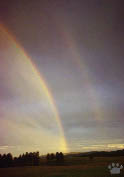
Double rainbow, Badlands
Nat'l Park, South Dakota. |
Crow Indians called the Great Plains
"the country of big sky". It is one of the World's best places to watch
thunderstorms and rainbows. More tornadoes and supercell thunderstorms occur here
than in any other part of the planet. The peak season is late April to early July,
and the average date with most tornadoes is May 17, that happens to be my birthday.
Since my arrival to the US, I try to celebrate my birthday in the Tornado
Alley (part of the Plains between Omaha, Nebraska and Lubbock, Texas) each
year. I took this picture a few minutes after a very strong June thunderstorm
(HP supercell) with lots of rain, hail and wind. There were no tornadoes, but
after the cloud had passed, I was awarded with such a beautiful sight. |
| In mid-summer, thunderstorm activity spreads from Tornado Alley
to the far northern and western parts of the Plains. This spectacular July thunderstorm
in Alberta produced little rain, but lots of beautiful cloud formations and rainbows.
Supercell thunderstorms are also known for large hail, sometimes melon-size, so
it's better to chase them in a rental car with good insurance coverage. |
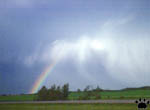
Rainbow under a supercell cloud,
Beaver Lake, Canada. |
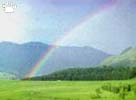
Spring rainbow, Tum, Altai. |
In the Old World, one of the best places to see rainbows is in
Altai Mountains. The meteorological crossroads of Eurasia, Altai gets summer rains
from all directions, and rainbows can be seen almost daily from mid-May to early
August. Thunderstorms are more severe in the foothills, but more regular in the
high mountains of Central Altai. |
| Rainbows are less common in tropics, because there the sun is
too high overhead during most of the daytime. Still, if you are in the mountains,
you sometimes can see the rainbow by looking downhill. Mornings and evenings are
also good times for tropical rainbows, especially in "wet" mountains
of Hawaii, Central America, Southern China, the Sundas, and Central Africa. This
unusually bright rainbow was visible for more than an hour during a pleasant warm
February shower. |
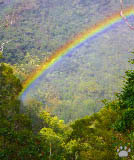
Winter rainbow, Oahu, Hawaii. |

Baobabs in a thunderstorm, Zombitsi National Park, Madagascar. |
South from the tropical latitudes, rainbows become common again.
They are often very bright in spring,
probably due to constant freezing and melting of raindrops as they move through
different layers of cold air. |

Small spring rainbow,
Carretera Austral, Chile. |
| The Arctic also gets it share of
rainbows, but they are rare here, and seem bright only relative to the tender
colors of the North. The good thing is, they can be very long-living, just as
Northern sunsets and sunrises, a photographer's dream come true. This charming
rainbow was seen one June midnight in Yukon Territory, Canada, just north from
the Arctic Circle. It lasted for more than two hours, and moved slowly along a
mountain range, as the sun circled the sky on the other side of the horizon. |
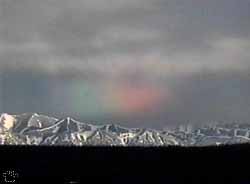
Rainbow over Richardson Mountains, Canada. |

October rainbow, Central Labrador, Canada. |
This rainbow above the Trans-Labrador Highway was unusual because
it appeared at a very low temperature - well below freezing. It was accompanied
by light hail. Apparently there was a sharp temperature inversion just a few hundred
meters above the ground, so the rain droplets didn't freeze until falling into
the layer of cold air. |
| Some rainbow-like things you see in the sky are not rainbows
at all. Halos, for example, are formed when sinlight gets through thin cloud layer.
Unlike rainbows, they are usually seen more or less on the same side of the sky
with the sun, not the opposite one. Depending on cloud composition, halos can
form either a full circle around the sun or the moon, or two, sometimes four,
sundogs - bright spots on both sides of the sun ("sun's mittens", as
they are called in Siberia, where people believe them to be a sign of a frosty
night coming). Here
is an excellent page about halos and similar phenomena. |

Halo on cirrus clouds, Badger Pass, California. |
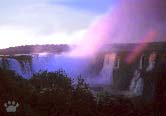
Monochromatic rainbow,
Iguazu, Argentina |
When the sun is very low, the atmosphere sometimes filters away
all colors, except red, as can be seen in this pink rainbow. Pink rainbows are
very rare, and they usually turn into multi-colored rainbows (if the sun is rising)
or disappear in less than one minute. |
| As the sun rises higher, the rainbow quickly becomes multicolored
and much brighter. On this picture, taken few minutes later, yellow and green
colors are already in place, but blue is still weak |

Multicolored rainbow, Iguazu, Argentina |
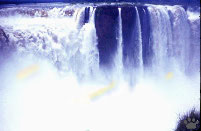
Triple rainbow, Iguazu, Argentina. |
Finally, about 30 minutes after sunrise, the sunlight gains all
colors, and rainbows become complete with blue and purple. In the middle of the
day, the tropical sun is high overhead, and the rainbows you can see in large
waterfalls are sometimes very bright and beautiful. |
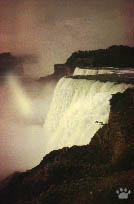
Moonlight rainbow,
Niagara Falls, USA. |
To see a moonlight
rainbow (also monochromatic), you need dense clouds of water droplets - such as
in high surf or large waterfalls. Very rarely it can be observed in the sky after
rain, but in this case it is not so bright. Street lights can also produce small
yellow rainbows. A good place to look for moonlight rainbows is in
Yosemite, California - here the waterfalls are all around the valley, and
you can choose the one with the optimal orientation relative to the position of
the moon in the sky. |

Moonlight rainbow and Northern
Lights, Labrador, Canada. |
| Rainbows produced by waterfalls are
usually less bright than some of rain-associated ones, probably because water
droplets are too small. But some waterfalls also send large volumes of large droplets
in the air, as the water falls on rocks or canyon walls. Many waterfalls in Banff
and Jasper National Parks in Alberta, Canada, are located
in narrow canyons, and rainbows can be very bright at the times when the canyons
are in sunlight. |

Athabaska Falls, Jasper Nat'l Park, Canada. |
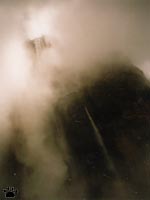
Salto Anjel, Venezuela. |
The most beautiful place to look for rainbows
is the south-eastern part of Venezuela, sometimes called Guyana Highlands. Hundreds
of waterfalls, many of them more than half a mile tall, drop from the cliffs of
the famous tepuis - spectacular mesa-like mountains.
In windy days, only big ones make it to the forest below - all water from others
is carried away. Anjel Fall is the tallest (more than 1 km), and the most beautiful
waterfall on Earth. If you are lucky to get there in a sunny day after a rain,
you can see dozens of rainbows as the river flies down through layers of clouds
and fog. Swimming suit is the best clothes for such a visit - you'll get soaked
anywhere within a mile from the waterfall. |
| This rainbow was hovering inside a small, vapor-producing crater
in the middle of a very dry lava desert. The colors were unusual, probably because
some wave lengths were absorbed by volcanic gases. In addition to the rainbow,
the crater was inhabited by endemic moisture-loving ferns and millipedes. |

Rainbow in a volcanic crater,
Isabela, Galapagos Islands. |
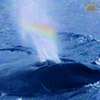
Humpback whale spout,
Monterey Bay. |
Another unusual place to look for rainbows is in whales' spouts.
You need to get close to see them - 20-30 meters (60-100') is usually the optimal
distance. Monterey Bay, California, is one of the best
places to do so. Powerful bush-shaped spouts of humpback whales are usually the
best for rainbows, but tall spouts of blue whales or weak spouts of gray whales
can also produce some. |
| One summer day I was caught in a sudden thunderstorm
while hiking up West Spanish Peak in Colorado. There was
nothing else to do but to keep climbing, so I endured half an hour of hail and
freezing rain - and was awarded with this view from the summit. |

View from Western Spanish Peak, Colorado. |
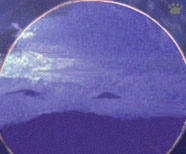
Sunset rainbow, Napa Valley State Park,
California (composition of 4 images). |
This was the most beautiful rainbow
I've ever seen. It was raining heavily all day, and it was already dark in the
forest, so this rainbow was a complete surprise. It was almost a full circle,
because I watched it from a mountain top; outside this circle everything was dark,
and inside there was still bright light from the setting sun... |

Desert rainbow, Death Valley, California. |
Home |

